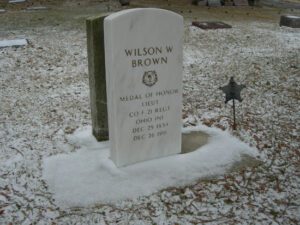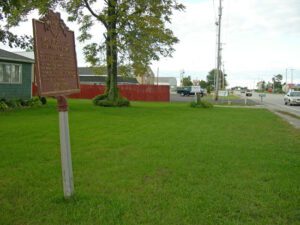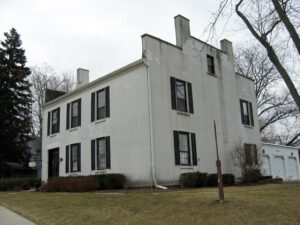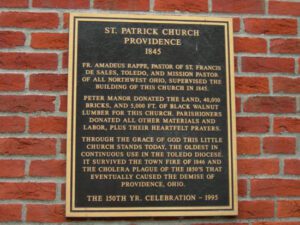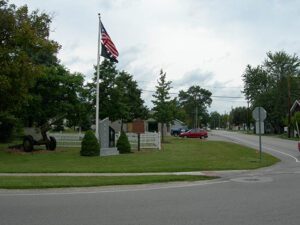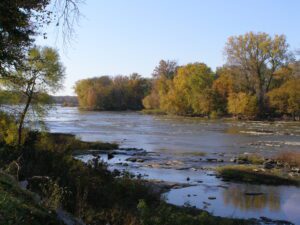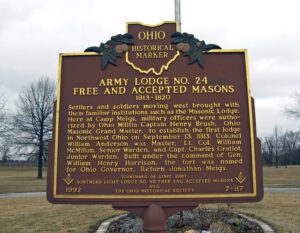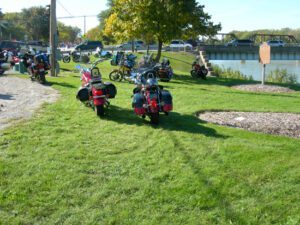, OH
Medal of Honor winner, who is buried here. He joined the famous Andrews Raiders to wreck Confederate supply lines. The raiders captured a locomotive, “The General,” at Big Shanty, Georgia, on April 12, 1862. Brown served as the engineer and was captured after the “General” ran out of fuel. He escaped on October 16 and made his way back to Union lines after enduring great hardships.
, OH
Elder Oliver Mears organized on February 8, 1862 in a tent on this spot, then a walnut grove owned by William Lovett, the Lovett’s Grove Seventh-day Adventist Church, first of this denomination in Ohio. A Frame building erected in 1864 served the congregation until 1911 when it moved to its present location in Bowling Green.
, OH
Old Wood County Jail 1847-1870. Built in 1847, during the Presidency of Polk, when Perrysburg was the County Seat, and used as the Jail and Infirmary until 1870. Continued to serve as the Perrysburg Jail until 1899, sold by the town in 1918. Acquired and restored by Mr. and Mrs. Charles W. Hoffmann in 1954. Listed in the Historic American Building Survey and National Register of Historical Landmarks, Library of Congress.
, OH
The town of Providence was born, thrived and died with the Miami & Erie Canal. It was platted in 1835 by French trader Peter Manor, swept by fire in 1846, ravaged by cholera in 1854, and finally unincorporated in 1928. Today, only the Irish builders’ St. Patrick’s Church (1845), the oldest in the Toledo Diocese; the cemetery; and Peter Manor’s house (1845) remain. The Providence Dam, built in 1838 to create a water supply for the canal’s remaining 25 miles to Toledo, was rebuilt in 1908. Peter Manor’s mill stands downstream one-half mile at Canal Lock #9, where it was built in 1822, rebuilt in 1846, and operates today as the Isaac Ludwig Historic Mill. The National Historic Register of Historic Places listed this district in 1975, the mill in 1974.
, OH
Thomas Howard, aged 66, a Revolutionary War veteran, arrived at the head of the great rapids of the Maumee from New York State in 1822. Three cabins were erected for his family and the families of his two sons Edward and Robert. The first death in this settlement was Thomas Howard in 1825; and this plot, then a wooded bluff on a sharp ravine, was chosen as a burial place. Other Howards were buried here, and in 1850, Tee-na-Beek, a family friend and one of the last of the Ottawa Indians in this area, was laid to rest in a corner of the family cemetery. WPA workers leveled the ground and relocated many graves in 1938. The Howard Cemetery is now owned and maintained by the Village of Grand Rapids.
, OH
This site, at the head of the Great Rapids of the Maumee, has been a major river crossing for centuries. The village was platted in 1833 as Gilead but was overshadowed by rival Providence during the canal era. In 1868 the name Grand Rapids was adopted, and the town prospered with the arrival of the railroad in 1877. Fires ravished the village in the late 1890s and spring floods have remained a threat. Restoration of the Victorian architecture began in 1975 and has helped revitalize this village along the historic Maumee.
, OH
Settlers and soldiers moving west brought with them familiar institutions such as the Masonic Lodge. Here at Camp Meigs, military officers were authorized by Ohio Militia Captain Henry Brush, Ohio Masonic Grand Master, to establish the first lodge in Northwest Ohio on September 13, 1813. Colonel William Anderson was Master, Lt. Col. William McMillan, Senior Warden, and Capt. Charles Gratiot, Junior Warden. Built under the command of Gen. William Henry Harrison, the fort was named for Ohio Governor, Return Jonathan Meigs.
, OH
This site is dedicated to Dominick Labino, 1910-1987, glass scientist, engineer, artist, and inventor. Credited with 57 patents, Mr. Labino invented pure silica fiber which was used in insulating tiles covering the space shuttle Columbia and the Apollo, Mercury, and Gemini spacecraft. As a glass artist, Labino was co-founder of the studio glass movement in America. His art works are in over 60 museums in the U.S. and abroad, and his architectural elements of hot cast panels are in many public buildings. His forte was original formulation of glass of high quality, durability, and unusual color effects. A resident of Grand Rapids since 1956, he was a benefactor and warm friend to the village.


